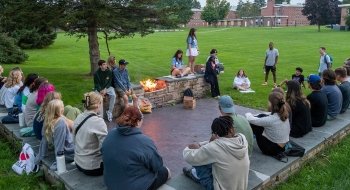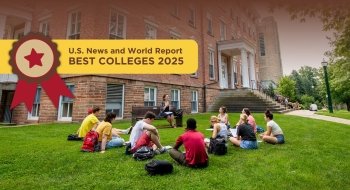St. Lawrence University Expands Its Use of Clean Energy
St. Lawrence University has entered into two long-term agreements that will provide approximately half of the University’s electrical power needs with renewable clean energy. Together with their clean energy offset purchase program, these agreements will ensure that nearly 100 percent of St. Lawrence University’s electricity will come from clean sources by summer of 2016.
“Several years ago, the University made a commitment to strengthening its environmental stewardship,” said President William L. Fox ’75. “The hydro and solar agreements we have committed to are one more step by St. Lawrence on that important journey.”
St. Lawrence finalized a long-term operating agreement for clean hydroelectric power with Gravity Renewables. The University will benefit from power generated at the Kings Falls small hydro facility in Lewis County, New York. The dam and its power generation unit were damaged during Hurricane Irene in 2011, and the project has been offline since. The agreement allows for the refurbishment and repair of the dam. The facility, which is expected to provide the campus with the equivalent of 4.3 million kilowatt hours of electricity annually, is anticipated to become operational in late 2015.
The University has also entered into a long-term agreement with California-based SunEdison, Inc., the largest global renewable energy development company, which is planning to construct a greenfield solar array in Oneida County, New York. The facility, expected to become operational during the summer of 2016, would provide the campus with the equivalent of 3.35 million kilowatt hours of electricity each year.
“Gravity and SunEdison are terrific partners,” said Dan Seaman, chief facilities officer for St. Lawrence, “and their production facility designs are expected to provide a steady, reliable source of clean electrical power for many years to come.”
Operationally, both clean energy facilities will provide their electricity directly to the grid. Through a process known as monetary remote net metering, or MRNM, the economic benefits of the transactions are transferred back to St. Lawrence via its utility bill. The annual savings is expected to average one-fifth of the University’s current electrical utility expense.
“This is a true example of a win-win result for our community, an expansion of our use of alternative energy and the opportunity to improve our economics at the same time,” said Joe Manory, St. Lawrence University’s chief financial officer. “Several people from Facilities and Finance, including Rick Scott, Louise Gava and Carol Gable, were instrumental in helping us put these arrangements in place and deserve a special thank you.”
Beginning in July 2015, St. Lawrence began purchasing 50 percent of its electricity as certified renewable wind energy credits through its supplier. When both the hydro and solar facilities come online, approximately 95 percent of St. Lawrence’s electrical supply will be considered from clean energy sources.



